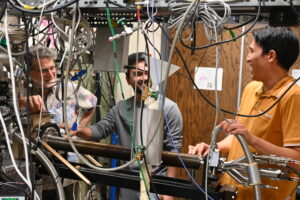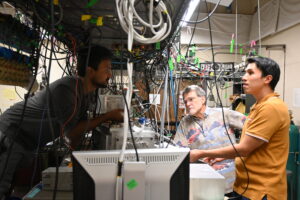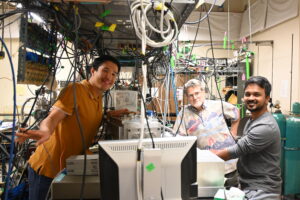We interviewed two postdoctoral fellows, Hugo Samayoa Ovied, and Lokesh Saravanan, to gain insights into what life is like as a postdoc here at U Chem, and the fascinating discoveries they are contributing to the world of research. Hugo and Lokesh work in Scott Anderson’s lab, whose research is centered around nanoparticle surface chemistry.

Tell us about yourself and the focus of your research.
Lokesh: I’m a postdoctoral researcher in Prof. Anderson’s group at the University of Utah, where I focus on advancing electrochemical applications, especially in energy conversion. My passion for this field started with a deep interest in how fundamental science can be used to tackle global energy issues. With a Ph.D. in Physics from National Dong Hwa University, Taiwan, I’ve built a strong foundation in material science, catalysis, and electrochemical systems. Specifically, my research focuses on developing catalysts for electrochemical applications and exploring sustainable energy solutions, all while sharpening my skills in material characterization. My motivation behind this research is to make meaningful contributions towards a cleaner, more sustainable world.
Hugo: I completed my undergraduate studies at UNAM in Mexico City. After finishing my undergraduate studies, I worked as a high school teacher before applying to Purdue University to pursue my PhD degree. During my time at Purdue, I worked with Dr. Julia Laskin on a mass spectrometry technique called ion soft landing. With this technique, we can prepare well-defined interfaces using ions of a particular mass-to-charge ratio. I became excited about this approach because it enables the study of isolated ions in the condensed phase and allows for the preparation of high purity materials. I am passionate about teaching, and during my time at Purdue, I had the opportunity to participate in course development and teach the undergraduate Analytical Chemistry class. I found the perfect balance for my two passions -teaching and conducting research -by mentoring undergraduate students in the lab. It was incredibly rewarding to see the students I worked with present their scientific findings at local and national conferences.
Now in my postdoctoral position I have transitioned into surface science and using size-selective deposition of clusters to prepare interfaces that are relevant for catalysis. My goal is to use these techniques to gain fundamental understanding that will enable the rational design of interfaces tailored towards higher catalytic performance in synthetic organic electrochemistry applications.
Can you describe the project you are currently working on?
Lokesh: Earlier, Prof. Anderson’s group working on depositing size-selected platinum clusters on Highly Oriented Pyrolytic Graphite (HOPG) for hydrogen evolution reaction (HER), oxygen reduction (ORR) and propanol oxidation. However, due to the instability of the Pt clusters on HOPG, sintering occurred during deposition. This caused the size-selected Pt clusters to break down into extremely small species, like atoms and dimers, while also forming larger ones. To address this issue, I’m currently working on anchoring Pt clusters on nitrogen-implanted HOPG to stabilize the clusters and improve their performance in electrochemical reactions.
Hugo: One of the projects I am working on involves the deposition of size-selected Pt clusters to investigate how the size (number of atoms) of the cluster affects its catalytic activity. Platinum electrodes are widely used for catalytic studies in the solution phase, but it is still challenging to create bulk electrode interfaces with a well-defined composition that are tailored towards a particular application. By studying how catalytic activity changes with the size of the Pt cluster, we can better understand specific solute-catalyst interactions to better design electrode materials with improved performance towards electrochemical or synthetic electrochemical reactions of interest.
Another project that I am starting to work on is related to carbon dioxide capture in ionic liquids (ILs). CO2 can be trapped into the bulk of ionic liquids after diffusing into the cavities formed in their ionic structure and trapped by different chemical interactions. One unsolved question in this field is the mechanism by which CO2 is captured into the bulk of the IL. Scott developed a technique that enables the isolation of a single nanoparticle-size ion to study the changes it undergoes after being exposed to reactive gases (CO2, for example) or increased temperature. CO2 capture events occur at the IL-gas interface and by trapping a single ion of a defined surface area (size), we can better understand how ILs change their reactivity towards CO2 as their surface changes over time.
What led you to Professor Scott A’s lab?
Lokesh: During my Ph.D., I worked on Ruthenium-modified Tungsten diphosphide (Ru/WP2) for hydrogen production, where the ruthenium species ranged from 3-10 nm. I noticed that the nano-sized species had much higher hydrogen production efficiency compared to bulk materials, which sparked my curiosity. From that point on, I became fascinated with clusters and single-atom species. When I came across Prof. Anderson’s group, who were working on clusters for hydrogen evolution reactions and other electrochemical processes like oxygen reduction and propanol oxidation, I knew I had to join. The impressive work coming out of his lab is what drew me to his lab.
Hugo: Scott has a lot of experience in surface science, and by joining his lab, I hope to gain experience in various surface characterization techniques that will complement my background in preparative mass spectrometry. Another major motivation for joining his lab is the opportunity to contribute to several collaborative projects he is involved in. As scientists, it is important to build a strong network of collaborations, and I enjoy participating in cross-disciplinary research. Scott maintains strong collaborations with theory groups and is part of the Center for Synthetic Organic Electrochemistry (CSOE). I believe that being involved in these collaborative efforts would be both scientifically exciting and would provide an opportunity to interact with researchers from diverse fields.
What led you to this specific project? What discoveries have you both made so far?
Lokesh: My interest in working on clusters and single atom catalysts for electrochemical reactions, combined with my strong motivation to contribute to a cleaner and more energy-efficient future, is what drew me to this project. I’ve always been fascinated by how these tiny structures can have such a significant impact on catalytic activity and efficiency. The potential to push the boundaries of electrochemical reactions and develop sustainable energy solutions is not just exciting, but also deeply aligned with my long-term goal of advancing technologies that can address global energy challenges. This passion is what ultimately led me to pursue this project.
Hugo: The size-selected deposition of clusters provides fundamental insights that we hope can answer questions in the fields of catalysis and synthetic chemistry. Part of my excitement to join this project is being part of the CSOE, which brings together scientists from different fields -organic chemistry, electrochemistry, theory, and physical chemistry- to explore electrochemistry can be used to synthesize products with chemical selectivity and high yields. So far, we have been focused in showing that clusters of a particular size are better suited for selectivity in electrochemical processes. However, this is more challenging than it sounds. Clusters tend to aggregate quickly on surfaces, so we have to be creative and find approaches to stabilize them on the surface. The project is still in its early stages, but I am looking forward to the discoveries we will make!
How will your discoveries advance the field of chemistry?
Lokesh: The development of efficient catalysts for electrochemical applications, particularly in energy conversion, supports the principles of green chemistry by promoting energy-efficient processes and reducing harmful byproducts. Electrochemical studies offer insights into fundamental chemical processes, such as electron transfer, adsorption and desorption at material surfaces. These insights can lead to a deeper understanding of reaction mechanisms, driving advancements in fields like surface chemistry, electrochemistry and catalysis. Such understanding is vital for designing better catalytic materials and improving industrial chemical processes.
Hugo: There is a high interest in the field of chemistry in developing novel methods for synthesizing products using green chemistry approaches, such as synthetic organic electrochemistry. I believe that by elucidating the key factors that influence catalyst-substrate and catalyst-support interactions, we can better design electrode interfaces that will open-up more ways of doing efficient organic electrochemical transformations.
What excited you most about this project? How will it contribute to your future career?
Lokesh: What excites me most about working with clusters is not only their remarkable activity compared to bulk materials, but also the ability to minimize the amount of catalyst needed, which reduces overall costs, making it a vital step towards developing more cost-effective solutions for the future. By exploring new possibilities in electrochemical energy systems, I aim to contribute to the global shift towards renewable energy and reducing our environmental footprint. It’s incredibly rewarding to play a role in this transformative shift towards a more sustainable future.
Hugo: I am particularly excited about performing electrochemistry experiments under surface science conditions (i.e. ultra high vacuum environment). Conducting these experiments at low pressures greatly minimizes air contamination, which is critical because platinum clusters are highly reactive, and their performance significantly decreases when exposed to atmospheric conditions. I find the experiment to be neat, challenging, and rewarding, as it provides valuable insights into the inherent chemical properties of the catalysts. By learning this technique and collaborating with the team at CSOE, I hope to broaden my scientific horizons and create meaningful connections with my colleagues at the University of Utah and within CSOE.
(Statement in collaboration with Scott A) Why does this project matter? What does it tell us about science?
Lokesh: This project showcases how fundamental research in chemistry can lead to practical, real-world solutions. It highlights the importance of understanding molecular and atomic-level interactions to create better materials and shows that scientific exploration can pave the way for innovations that can help combat global energy and environmental challenges.
Hugo: Chemistry is truly fascinating. I am constantly inspired by the newer developments, techniques, and approaches from scientific labs across the world. What I find particularly beautiful is to see that, while science is incredibly diverse, it remains highly collaborative. We believe that the size-selective deposition of clusters for studying electrochemical transformations is a powerful approach for understanding fundamental processes that affect the efficiency of electrode interfaces. The ability to precisely tune the size of catalytic centers on the electrodes gives us a new variable to control to optimize properties, but also enables new understanding of catalytic mechanisms. We are fascinated to learn new things about the atomic and molecular processes happening on those interfaces. But we are even more excited to see how these results contribute to a broader context where multiple labs across the US are collaborating in finding ways to create unique products using more efficient and environmentally friendly processes!


Learn more about Scott Anderson’s research group.
Get more information about Chemistry Postdoctoral Fellowships.
4/3/2025
